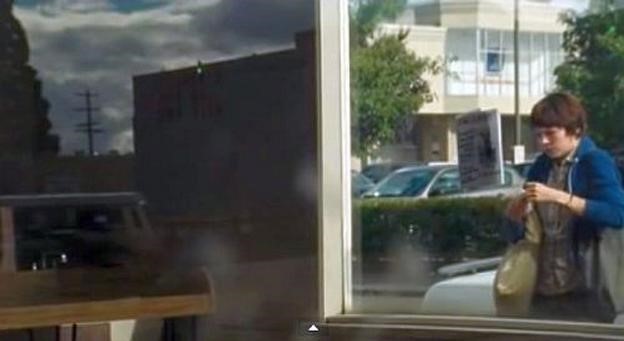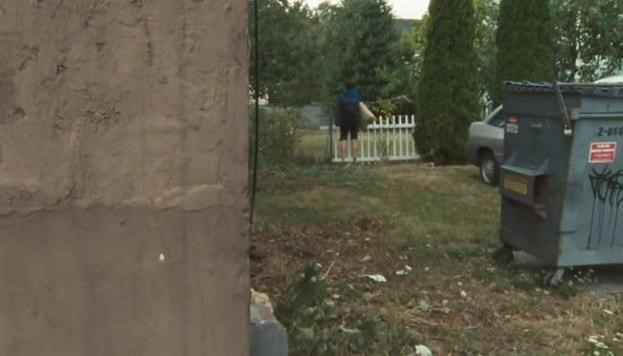This guest post written by ThoughtPusher appears as part of our theme week on Women Directors. Spoilers ahead.
A version of this post previously appeared at Bright Lights Film Journal. It now celebrates the recent release of Certain Women, a series of vignettes set in small-town Montana directed by Kelly Reichardt and starring Kristen Stewart, Michelle Williams, and Laura Dern.
The lateral pan 50 minutes into Wendy and Lucy kills me. The 2008 movie follows a simple enough story: girl and dog travel through a train-yard town, girl’s car breaks down, girl loses dog, girl finds dog in a better situation, girl leaves alone on a freight train. It is one in a series of stories from the writer/director about someone “passing through.” Through the course of the film, Kelly Reichardt’s pacing is so deliberate that even the most ordinary moments seem intensely significant. Reichardt’s framing traps Wendy in shots as much as her broken-down car and lack of money trap her in the town. But I cannot escape the lingering grasp of that pan. It just breaks my heart every time I see it.
Having lost her dog during a day-long stint in the local police precinct for shoplifting food, Wendy begins a search for Lucy who was left tied to the bike rack outside of the grocery store. Wendy tapes an “I’m lost” flyer with Lucy’s picture and description to a storefront window and walks away, but her movement doesn’t draw the camera’s gaze. All I see is the scene Wendy leaves behind: a soda machine and passing cars reflected in the glass that now holds the symbol of a tragic loss, simultaneously the symbol of a hopeful return. Then the camera starts to shift. Slowly. Too slowly. Is Lucy in the alley? Is there something written on that wall which seems to take minutes to glide over? What draws the camera’s gaze since it didn’t swish to keep up with Wendy when she walked away? Where is the camera taking me and where is this story going?
The distance traveled in that pan seems infinite: from the window, then along the building’s wall, and finally around the corner to see Wendy walking toward a fenced-off field (at which point she beckons to Lucy in a voice much smaller than Michelle Williams’ presence). In order to cover the apparently infinite space, that pan seems to last an eternity. Actually, it takes only a few seconds to cover a short distance, and the pan is only one among many employed in the film; but damn if it doesn’t crush me in a way no mere pan should.
A conventional pan should be a horizontal pivot of the camera which reveals a lateral view of scenery or action, particularly by following a moving subject. But Reichardt’s pan breaks the mold and imposes narrative significance to a cursory moment in Wendy’s story. The solitary pivot point of the pan doesn’t give me a stationary place of reference to make sense of the movement, and what is revealed in the course of the pan is not an environmental relationship between the storefront and Wendy. Rather, the pan shows me that I am limited in who I can see, what I can know, and where I can go. I’m just as bound to the isolation and desperation of a search without a foreseeable end as Wendy is as she calls out yet again and wonders about Lucy’s fate. (And I begin to wonder if Reichardt is telling a story about a drifter or documenting the reality of moving from film to film without a view as to her own professional future. As sad as that prospect seems, I reenter the film and think about the impact of that pan.)
The connection between Wendy and Lucy is severed, so even the story’s focal point seems lost. Wendy worries about Lucy and puts every effort into finding her, only to leave her once she is found. Wendy’s impoverished situation makes each of the choices she faces seem binary. Either she loses some of the limited money she has or she tries to steal food. Either she reclaims Lucy or she leaves her in a stable home. Either she moves forward or backward. Unlike so many other road movies, Wendy never feels the freedom of open possibilities. She is moving on a track from point A to point B, and she does not diverge from a determined path. Her journey is like that pan, slowly moving from one place to another, and whatever she experiences is just another point on a line that must be traveled in order to reach the destination.
I think the pan itself actually makes me feel the grief that follows the loss of a friend. On the surface, it is devoid of meaningful content; but maybe the effect is supposed to underscore the contextual space that opens for Wendy in a life without Lucy and foreshadow Wendy’s solitary departure from the town. The steady movement of that pan etches a line across the horizon of possibilities within the film: there is no freedom experienced in this traveler’s tale since Wendy is shackled by financial and social limitations as she journeys across the country. The function of that pan in some way binds me to Wendy as I eventually catch up to her, but the camera lacks any purpose that extends beyond finding a familiar character to latch onto. It is as if the camera’s gaze merely seeks a place to rest from this unending unknown, and that might be Wendy’s true quest in the film.
Thus attached to that pan, my motivation for attentive analysis is lost, as absent as Lucy from Wendy’s field of view. I don’t know where to find meaning and instead I find myself on shaky ground, if any at all, as if no tripod could support the weight of interpretation. The delay leading up to that pan makes the camera seem lethargic, imposing its own sigh in the midst of a sad situation. During that pan, the camera doesn’t just pivot: it floats from the flyer’s symbol of a search to the distraught searcher, both of which are disconnected from the object of the search; and I am left hanging like the flyer, one copy from a stack just like it, posted alongside other flyers for other lost dogs. Stripped of conventional purposes such as establishing a relationship to other characters or demonstrating the vastness of the environment, that pan makes me hover and drift. I am a ghost doomed to haunt the Oregon landscape, trapped alongside Wendy in this lost world.
Wendy’s ordeal in the film is comprised of just a few days in a longer journey; but that short time slowly develops into systemic uncertainty with increasingly intense vulnerability to invasions by unknown others and explores the bitter circumstances involved in negotiating the mundane details of a marginalized life. In the middle of the film, that pan evokes a sense of alienation and suggests Wendy’s lonely departure alongside an empty space. By the end of the film, Wendy has no safety net, no social network, no clarity of purpose… just like me with that pan. A life without significant attachments, an inability to escape the trappings of necessity, the meandering that accompanies an indefinite future: all conveyed painstakingly in a simple pan, an occasion fit for heartbreak.
ThoughtPusher might live somewhere near you (especially if you have a neighbor who blasts New Order or Tears for Fears most nights), but certainly is a cinephile who has no interest in being followed or asking to be liked.



1 thought on “Kelly Reichardt’s ‘Wendy and Lucy’: Heartbreak in a Panning Shot”
Comments are closed.